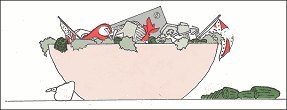
Then on May 30, several dozen people went to the Zurich Operahouse to demand that the money donated by the city to refurbish the Operahouse be given instead to fix up an abandoned factory building behind the railroad station on Limatstrasse, so that it could be used for such a center.
The demonstrators threw eggs and insults at the audience as it was coming out of the opera, and a battle with the police ensued. A full-scale riot developed, with selective looting and vandalizing of jewelry, clothing, and hi-fi stores, as well as the cafe Odeon, which was once a favorite hangout for many young people, but has recently become posh and expensive.
Throughout the month of June, there were general assemblies four to five evenings a week followed by spontaneous street demonstrations of 2,500 to 4,000 people. Intense fighting with the police occurred on more than one occasion. The demonstrations weren’t only to demand the youth center, but also to demand the right to live and breathe in stolid Switzerland, and “a space outside the law.”
There were several pirate radio stations on the air that regularly broadcast the locations of demonstrations, and called on people to join, and informed participants of the movements of the cops. Sometimes they pirated frequencies of the regular radio stations, as when 300 people invaded the offices of the Neue Zuricher Zeitung (equivalent to the New York Times) and proclaimed, “You’ve been shitting on us… Now we’re here to write the front page!” After a half hour of fighting with the cops and some vandalism, the crowd had grown to 2,500, mostly people who had responded to the pirate radio stations’ calls.
At the beginning of July there was a demonstration of more than 9,000 people. Afterwards, they all went to a park, bringing wood from construction sites with them to build bonfires and a stage. A street play was given, with many references to riots, which were enthusiastically cheered by the crowd.
After this demonstration the city authorities finally granted the money, and on July 2 the center was opened; but the general assemblies and demonstrations went on. The center was closed in a week due to pressure from “respectable citizens.” The demonstrations, rioting, looting, etc. continued.
On the night of July 12, 6,000 demonstrators erected barricades in the center of the city and confronted the cops. The police brought out their two anti-riot cars, which hadn’t been used since 1968 (when graffiti had been written all over them). The demonstrators shouted, “Make cucumber salad out of the state,” in front of the city hall. Fighting went on into the early hours of the morning.
The movement has no leaders, no organization or ideology; this disturbs the authorities very much. Demonstrators and vandals cannot be easily spotted beforehand, since they don’t wear jeans and leather jackets, or any other uniform, as in former years. They are not primarily students or from any particular social background. They are mainly young people from all parts of town and all social milieux.
In the general assemblies, everyone participates equally. None of the protesters pretend to speak in behalf of the movement. No one wanted to vote for or serve on a delegation to negotiate with the authorities. The city officials would have to talk to everyone or no one. One of the main slogans of the movement has been, “No power to anyone.”
The mayor and the city council people were told they had to come to the general assemblies if they wanted to talk things over. They finally came to one and had to wait an hour and a half before speaking, because “urgent matters” were being discussed. When city council members offered the opportunity for “spokespeople” to participate in a televised debate, the two protesters who responded addressed themselves for three-quarters of an hour, to the subject, “Why All Young People Should Be Shot,” just to make things interesting.
One demonstration took place on such a hot day that everyone stripped and went through the streets naked. Another finished with a bath of 6,000 in Lake Zurich, everyone skinny-dipping. This kind of thing has been hitherto unknown and unimaginable in Switzerland.
As of October 11 things were still going on in Berne and Zurich. That day over 500 young people marched in Berne behind a large banner reading “We don’t want a society in which the risk of dying of hunger is exchanged for the risk of dying of boredom!” As compared with a demonstration the week before, when the cops were out in force, this time there were few to be seen and very few “incidents.”
Also on October 11, in Zurich, groups of people descended into the Bahnhofstrasse to try to talk to passersby about the problems of young people. They handed out leaflets calling for the reopening of the Autonomous Youth Center, the freeing of people still in jail from previous actions and affordable housing in the city. They were forcibly dispersed by large numbers of police.
